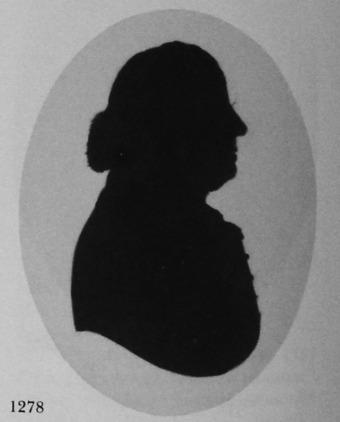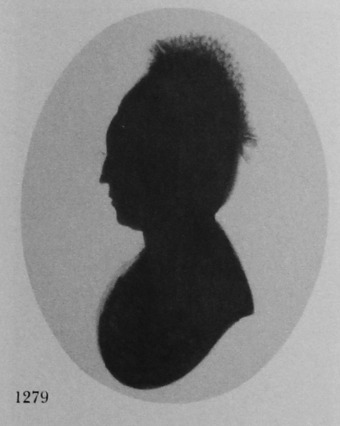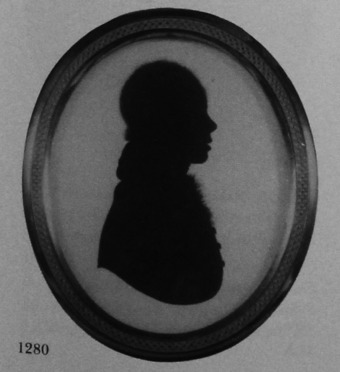Lovell, Thomas (McKechnie Section 4)
See also Section Five
An artist, recorded by Mills, who worked for a period (1799-1801) in John Miers's studio at 111 Strand, London, and then worked independently. His association with Miers is mentioned on Lovell's trade label, and recent research suggests that he was not a young man when he took up silhouette work. Details of Lovell's career, and the period during which he worked in Miers's studio, have been established by recent research carried out by Mr P. G. Higgs, who has examined the land tax assessments, parish registers and directory entries relating to the address given on Lovell's trade label: 32 Bread Street, Cheapside.
1281
Land tax assessments for 1780-1808 for Bread Street Ward, Parish of St. Mildred's, Lower Precinct, 32 Bread Street, Cheapside, are as follows: 1780, 1784, 1787, 1790, 1806, Thomas Lovell paid the rent of £24; 1807, Ann Lovell paid the rent; 1808, Jane Lovell paid the rent. From 1810, Lovell's name is not given. The registers of St Mildred's parish church record the baptism on 24 December 1780 of a son (John Figgins) to Thomas and Jane Lovell. The date of the birth of Lovell's son suggests that Lovell him-self was probably born no later than c. 1760. We must also assume from this entry that the name of Lovell's wife was Jane, and that the land tax assessment entry for 1807 gave her name as Ann in error. The parish register records that the burial of Thomas Lovell took place on 29 June 1806. (The relevant poor rate books, which might have substantiated the land tax assessment entries, are missing.) Directory entries for 32 Bread Street are as follows:
1780 Thomas Lovell, Glass Seller [Kent's Directory]
1781 Thomas Lovell, Glass Seller [Lowndes Directory]
1783 Thomas Lovell, Glass and Staffordshire Warehouse
[New Complete Guide]
1790 Thomas Lovell, Glass and Staffordshire Warehouse
[Universal British Directory]
1791, 1793 [as above]
1799 [as above, but in Holden's Directory]
1802 Thomas Lovell, Profile-Painter [Holden's Directory]
1805 Thomas Lovell, Profile-Painter and Jeweller [Holden's
Directory]
These entries suggest that in 1799 Lovell, aged at least forty, gave up his trade as a glass and pottery salesman and left Bread Street, presumably to start work in Miers's studio at 111 Strand, from which he returned in (probably) 1801 to set up as a 'profile-painter' on his own account. According to his trade label, he also worked as a jeweller and maker of frames for miniatures (both occupations which were carried on in Miers's studio). Lovell presumably learned the art of painting silhouettes on plaster at Miers's studio, but no silhouette from this studio, and unmistakably from Lovell's hand, has been positively identified. Since, on his trade label, Lovell especially mentions mourning rings, he may have specialized in jewellery work while at 111 Strand.
We are concerned here with the silhouettes which Lovell produced independently at 32 Bread Street between c. 1801 and his death in 1806. Most of the few known examples were not executed with particular skill. Some can hardly have flattered their sitters; possibly Lovell took up his art too late in life to acquire easily the skill of rendering a pleasing likeness in profile. It should be noted that the offer to copy `old Shades' is mentioned prominently on Lovell's trade label.
Lovell finished his bust-line with a blunt point at the back and with a curve of shallow convexity. Details of shirt-frills, and of the hair of both male and female sitters, is poorly shown in a spiky style (visible on the magnification photographs in this Section), with the addition of dark dots. A minor feature is the careful doming of buttons on men's frocks on several profiles; most painters on plaster showed buttons either as flat or concave.
All the examples which I have seen (except one) are housed in papier mâché frames with pearwood ovals. They are under convex glass, either plain or verre églomisé glass with a border of concentric lines (one in the centre white, and four more, of different widths, in gold interspersed with black). One example, owned by Mr J. A. Pollak, is framed in papier mâché with a `matting' ormulu oval of the style which was later made by William Miers at John Miers's studio.
1280
lls. 1276-1281, 1423, 1442, 1443

Mary Hooke
Silhouette painted on plaster
c. 1802
3 ½ x 2 ¾ in./90 x 70mm.
Frame: papier mâché, with pearwood oval
The trade label has been destroyed, but the silhouette can safely be attributed to Lovell on stylistic grounds. Mary Hooke (1755-1842; née Bloxham) married Lieutenant-Colonel George Philip Hooke in 1783.
Author’s collection

Unknown man
Silhouette painted on plaster
c. 1802
3 ½ x 2 ¾ in./90 x 70mm.
Frame: papier mâché, with pearwood oval and verre églomisé border
Although I have dated this silhouette on the assumption that it was painted from life, it may be a copy of an original by John Miers.
Donald Gildea collection

?Mr Astor
Silhouette painted on plaster
c. 1802
3 ½ x 2 ¾ in./90 x 70mm.
Trade label
Frame: papier mâché, with pearwood oval and verre églomisé border
Although I have dated this silhouette on the assumption that it was painted from life, it may be a copy of an original by another artist. The sitter may have been a Mr Crowther.
In private possession

?Mr Astor
Silhouette painted on plaster
c. 1802-03
3 ½ x 2 ¾ in./90 x 70mm.
Trade label
Frame: papier mâché, with pearwood oval and verre églomisé border
Companion to the silhouette illustrated in 1278, and, likewise, possibly a copy, although I have dated it on the assumption that it was painted from life. The sitter may have been Mrs Crowther.
In private possession

Unknown boy
Silhouette painted on plaster
c. 1805
Trade Label
Frame: papier mâché, with ‘matting’ ormolu oval and flat glass
A good example of Lovell’s work, definitely painted from life.
J. A. Pollak collection

Trade label of Thomas Lovell, from the silhouette illustrated in 1280.
J. A. Pollak collection
Detail

Hair. Detail from a silhouette of a boy by Thomas Lovell. The black, spiky strokes (added to give density), and the dots, are characteristic of this artist’s work (see also his style of painting a shirt frill in 1442). (1280)
J. A. Pollak collection

Shirt-frill. Detail from a silhouette of a boy by Thomas Lovell. The spiky black strokes, and the dots, are also typical of the artist’s treatment of hair (1423). (1280)
J. A. Pollak collection

Shirt-frill. Detail from a silhouette of a boy by Thomas Lovell. The typically dome-shaped buttons are clearly visible. (1280)
J. A. Pollak collection
